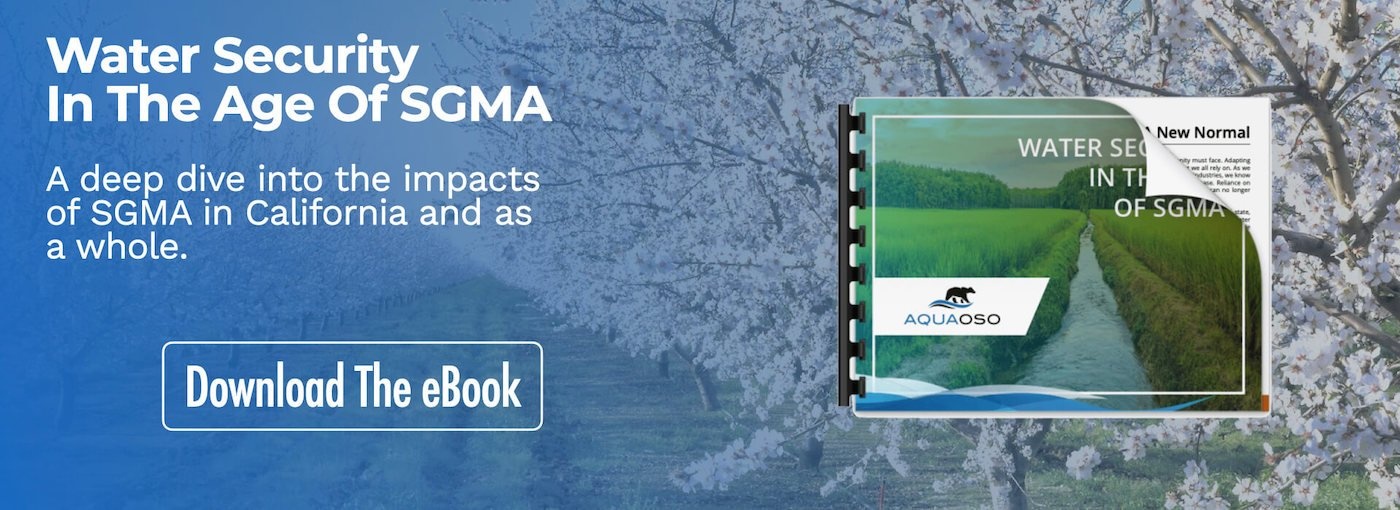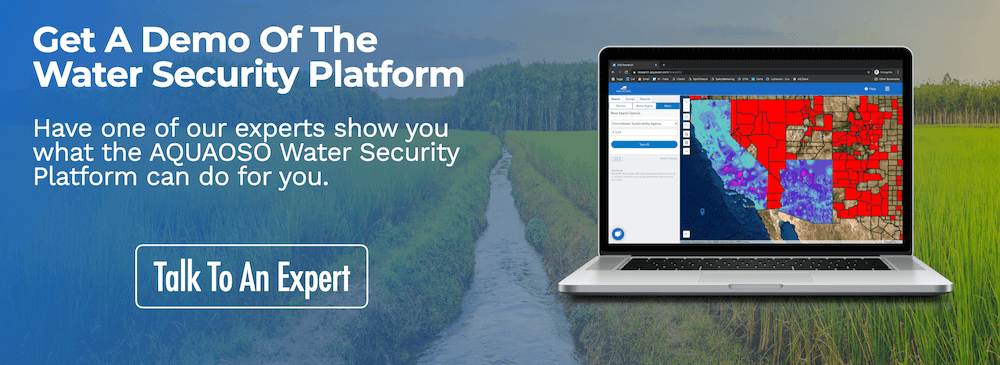Why Agricultural Irrigation and Water Conservation Are Intrinsically Linked

Part of our How to Conserve Water in Agriculture Guide
Agricultural irrigation and water conservation undeniably go hand in hand. While reducing water consumption in industrial and residential settings can play a role in addressing water scarcity, more efficient irrigation practices in agriculture can have an even greater impact. That’s because agriculture accounts for as much as 80 percent of water usage in the U.S., and more than 90 percent in some states in the West.
“In 2010, irrigated agriculture consumed four times as much water as urban users [in California].”
The good news is that reducing water usage in agriculture is easier than one might think. Between 1977 and 2010, the use of gravity irrigation in California nearly halved – from 6.5 million acres to 3.5 million acres – in favor of drip irrigation. And while installing new systems does cost money, the end result is that “farmers are using about the same amount of water as they did in the 1960s,” despite total productivity continuing to grow.
Let’s take a look at some of the inefficiencies in irrigation practices today, and how we can continue to improve agricultural irrigation to conserve more water.
How Inefficient Is Agricultural Irrigation?
To understand where there’s room for improvement in water conservation, we need to look at the entire irrigation process, from beginning to end. From the canals that bring water to drought-prone rural areas, to advances in water and soil sensors, these are some of the most important factors in determining irrigation efficiency.
Regulations
In many western states, farmers use a combination of groundwater and surface water to irrigate their crops. Water rights have historically been based on seniority, and there are often complex agreements between states, upstream and downstream users, and municipal buyers in order to ensure a fair and sustainable water supply.
But as we describe in our eBook, “Enabling Smart Water Markets,” sometimes this has the opposite effect, and incentivizes users to overpump so as not to lose rights to their water supply. This can cause “billions of gallons to be wasted every year.”
New regulations, such as the Sustainable Groundwater Management Act (SGMA), are working to change that, but there is still work to be done before groundwater markets are as “smart” as markets for electricity and other tradeable resources.
Water Transport
Much of the water that’s used in the American West – both for drinking and for irrigation – is transported via a complex system of canals and aqueducts. Although the Bureau of Reclamation has built over 8,000 miles of canals in the region, two-thirds of them “have been transferred to non-Federal operating entities to perform operations, maintenance, and replacement,” with plenty of opportunities for leaks and other failures.
“[U.S. Bureau of] Reclamation water irrigates 10 million acres of farmland and serves one in five western farmers.”
But not all states keep a close watch on these transport systems. According to a UCLA analysis, ”California doesn’t require careful monitoring and water retailers do not invest enough to track water lost to leaks and breaks.” Some retailers estimate an average of 3 to 4 percent loss, but based on data from countries that monitor their water leakage more closely, the true rate of water loss is more likely to be 10 percent.
Water Storage
Water harvesting and storage is one way in which farmers can protect their crops from droughts and water shortages. This can include collecting rainwater, as well as runoff from streams and catchments for use in future years. Some farms use aboveground storage ponds, while others use closed tanks and other man-made containers.
Regardless of which method is used, some loss may be inevitable, with “water stored in reservoirs [evaporating] at a greater rate than free-flowing water.”
Additionally, the capacity of individual reservoirs limits how much excess water they can capture when it’s available. Even when California experiences high levels of snowmelt, as it did in 2017, much of that water is washed into the sea.
Some studies suggest that by storing water in underground aquifers, “California could pump 10 times as much water into the aquifers as could be held by the new dams on the drawing board,” reducing strain on existing groundwater supplies.
Irrigation Methods
Irrigation methods vary from crop to crop and around the world, and some methods are more efficient than others. According to the U.S. Geological Survey, roughly 29.4 million acres used flood irrigation in 2000, while 28.3 million used spray irrigation.
Both methods can lead to some degree of water loss, with flood irrigation losing water due to runoff, and spray irrigation losing water to evaporation. In recent years, farmers have been shifting to drip and sprinkler methods, which can provide 70 to 90 percent efficiency, and also lead to reduced soil erosion and pest infestations.
How Can We Make Irrigation More Efficient?
While reducing leakage in water transport and storage, and shifting to drip and sprinkler irrigation systems can make a big difference, it doesn’t go far enough. If agricultural irrigation and water conservation are tied to each other, what other steps can we take to make irrigation more efficient and conserve scarce water resources?
Smart Water Management
The amount of water that crops need can change throughout the growing season, with weather, soil conditions, and even time of day influencing how much water is absorbed and how much is lost to runoff and evaporation. Farmers can use data from CIMIS, the California Irrigation Management Information System, to calculate “evapotranspiration” and “crop coefficient” measurements for their field based on weather data.
Some farmers are going one step further and installing their own soil sensors, which are now affordable enough to be installed on individual farms. Along with smart well meters, these devices can provide real-time data that farmers can use to improve the efficiency of their irrigation systems, and even, in some cases, automate them.
The closest comparison is with the smart devices that are now being used to monitor water and electricity use in residential homes. In fact, one environmental sensor, the Arable Mark, is designed by the same person behind the Nest thermostat.
These kinds of IoT devices can be paired with data collected from smart tractors and even drones to make more efficient irrigation decisions.
Smart Water Markets
Groundwater banking, trading, and other types of smart water markets can also play a role in water conservation by connecting buyers and sellers in the same basin. Existing networks make it difficult to determine where excess water resources are located, and even who has the rights to them. With algorithmic matching, that problem is solved.
Growers can make informed decisions about their water resources, with incentives to use their water more efficiently. It “allows growers who don’t use all their allocation in one year to bank that amount over to the next year to either use or sell.”
Trading groundwater resources also reduces the amount of water loss resulting from transport and storage, since it doesn’t require a physical transfer at all.
Plus, when surface water is plentiful, growers could earn credits for using surface water instead of pumping groundwater, helping to ensure aquifer recharge.
Crop and Field Management
Other techniques for conserving water in agriculture have to do with crop choice and field management. Here are just a few of the most effective solutions:
- Rotational grazing. This method involves pasturing livestock on the same fields used to grow crops. According to CUESA, “Good grazing management increases the fields’ water absorption and decreases water runoff, making pastures more drought-resistant” and reducing overall irrigation requirements.
- Dry farming. Commonly used in the Mediterranean region to grow grapes and olives, dry farming is becoming more popular in California wine regions. It uses tillage to preserve soil moisture during the rainy season, allowing crops to be grown during the dry season without the need for additional irrigation.
- Conservation tillage. This approach uses minimal tillage techniques to retain crop residue on the surface of the soil. This “can provide a cover that reduces wind and water erosion, runoff, or particulate matter and nutrient loss.”
Agricultural Irrigation and Water Conservation’s Connection
Efforts to improve agricultural irrigation include a wide range of practices, from installing the latest soil sensors to reviving time-tested farming strategies. Ultimately, the common denominator that links all of these approaches is knowledge: the more we learn about water, soil, and atmospheric conditions, the more efficient our practices can be.
You can read more about how to conserve water in agriculture in our comprehensive guide.
At AQUAOSO, we’re committed to expanding the collective understanding of water conservation, particularly when it comes to providing actionable resources on water risk.
You can browse our resources to learn more about water scarcity in the U.S., or reach out to our team for a demo of our water security platform. Together, we can use these tools to reduce water scarcity and achieve a more sustainable future.


